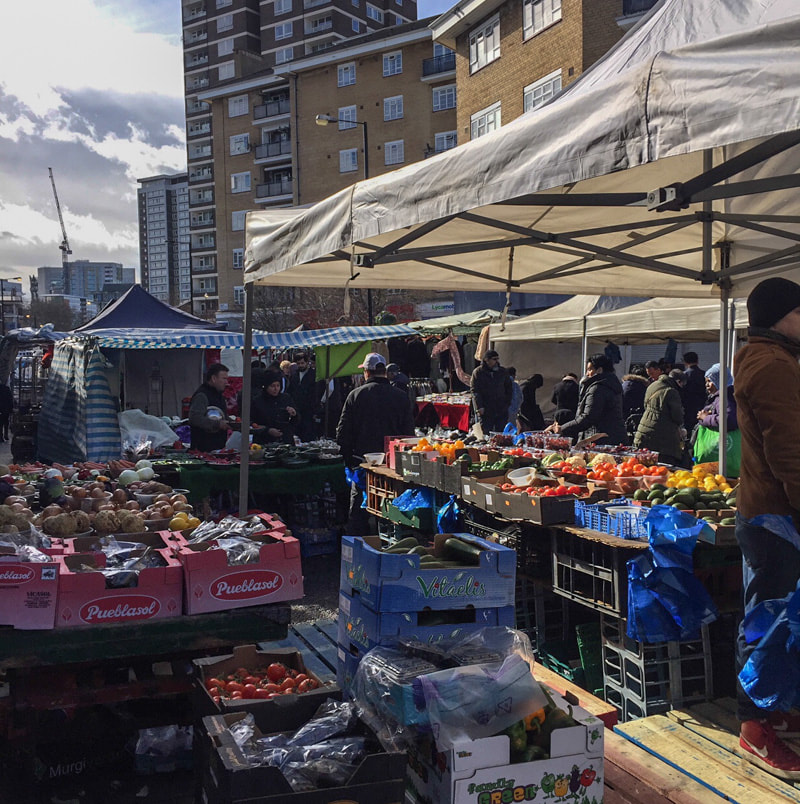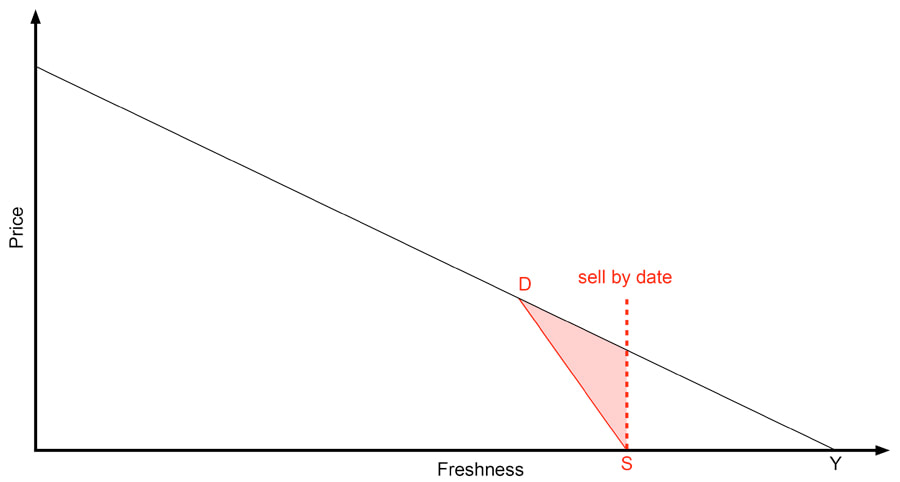|
When we think about markets we might think about greed, rapaciousness, the exploitation of position, the inequalities of outcomes, subjection of the public good to private gain and all the other ways of summarising everything that is wrong with market based economies. This blog looks at one archetype of a market; one that would have been immediately recognizable to Adam Smith in the 18th century. It describes the case of a contemporary central London street market. It provides an example of a market organized to fulfil a social purpose. This blog looks at the recipe for how a market with a social purpose is cooked up. The setting The market is situated on a street in Central London surrounded by social housing built at various times since the Second World War. Only steps away from the social housing are streets with households of much higher income and wealth, including those in adjacent new developments. The social mix includes immigrant communities, notably Arab, Nigerian and Bangladeshi. It is this area of social housing that is the key to the social purpose of the market. Products and prices The market operates on every day of the week, except Sunday, with Friday and Saturday being the main trading days. On the two busiest days there are up to 70 - 80 stalls and on other days 30 - 40. The range of produce and products on offer is wide - from clothing and footwear to housewares, costume jewellery, luggage, toys, plants and flowers, take-away hot food, groceries, fruit and vegetables and fish. The market is anchored by its fruit and vegetable offers (10-15 stalls depending on the day of the week). On Thursdays to Saturdays there are usually around 4 fish stalls. Meat is notable by its absence (I stall on I day). Prices are extraordinarily low. While, for reasons explained below, direct comparisons are difficult to make, fruit and vegetables are sold at prices 50% or more below those in neighbouring and adjacent supermarkets, and clothing at even greater discounts. Social benefits The social benefits of the market are mainly of three kinds. First, there is encouragement to entrepreneurship, particularly for immigrants. Secondly, there is employment on the stalls. Thirdly, there is indirect income support for low income families provided through the extremely low prices offered on basic food and clothing needs. It is the provision of these benefits that define the social purpose of the market. The most important of the benefits is probably that of indirect income support through low prices. Although a precise calculation is not possible, the effect of low prices could have the effect of boosting total weekly household incomes by the equivalent of at least 10% and possibly by 20% or more in the case of disposable income, after rent has been paid. The question is how the market is set up in order to deliver these social benefits and in particular to deliver such low prices. There are a number of possible reasons explored below. Trading fees Unlike shop owners, stall holders do not pay rents and business rates in order to do business. In order to set up a stall the stall holder pays an application fee (around £120 for stalls other than hot food take- away providers) and a daily fee (currently around £20). Licenses are granted on a first come, first served, basis and street spaces are allocated with regular locations for regular stall holders. Some stallholders are long-standing participants. In keeping with the entrepreneurship objective, there are many more recent ethnic Arab operators. One possible reason for the low prices available in the market, in addition to the absence of rents and rates, is that stall holder fees are subsidized. There are two ways of thinking about the measurement of any subsidy element. One is in relation to the demand for stalls. A level of demand in excess of the street space available would suggest prices set at less than a clearing price. There is no evidence for this. There is excess space available on all days - other than possibly on the busiest day (Saturday) when the available space is normally full. The other way of measuring the subsidy element is in relation to the costs of the services provided to the market by the local government authority, Westminster City Council (WCC). Infrastructure: electricity, storage & street cleaning, inspection and policing WCC provides electricity connections to some stalls run from adjacent social housing blocks. It provides for market licensing and inspection to check that stall holders have their licences and keep to their allotted space. There is a community police office on the street and a WCC operated toilet accessible to the stall holders who are key holders. Much the most important forms of support provided are permanent storage space for the traders in the form of sealed lockers in locations adjacent to the market, and a daily street cleaning service that operates both during market hours and also, more importantly, for the end-of-day clean-up. The street traders who avail themselves of the storage lockers are charged currently around £ 150 a month. This compares with a monthly fee for using a space in a commercial car park in the neighbourhood of around £250. The cleaning costs are meant to be recovered through the daily license fee. However, WCC has been running a deficit on its 6 street markets. It is thus reasonable to assume that the costs to WCC of providing street cleaning and inspection services are not fully recovered. Weights & measures; the scoop & the tray The lawful standard of measurement for produce offered in the market is in kilos and grams. However, most stalls offer, as well, the pre-decimal measures of lbs/oz. More importantly, many offerings take the shape of scoops, trays or boxes where weight is indeterminate and measurement depends on the eye of the buyer. Market smoothing and De-branding The very low prices available on household products, clothing and footwear might provoke suspicions of pirated goods and sourcing from off the ‘back of the truck’. Anonymous ‘white vans’ are ubiquitous. However, there is a rather more mundane explanation that centres on a traditional market function of taking advantage of fluctuations in supply and stocks at the wholesale or retail stage and on ‘de-branding’. The stock clearance function occurs in response to fluctuations in supply and availability at the wholesale or retail level that simply reflect misjudgements of demand for the product by wholesalers, producers and retailers. The market provides a way of disposing of excess and unwanted stocks. In the US there is an analogous clearing function performed by shoppers who buy off retail clearance racks or shelves and sell-on over the internet. In addition, the smoothing or clearance of wholesaler or shop retailer stocks also occurs for products that are offered by the market ‘out of season’ (for example Xmas products offered in the spring). Normal market smoothing of supply and demand at the wholesale level also appears to have a major influence on the market offerings of fruit and vegetables where quantities are highly variable. Alongside this market clearance function is an associated ‘de-branding’ function that also contributes to low prices in the market. De-branding takes two main forms. In some cases, producer, or manufacturer, brand labels or packaging may be removed. In other cases, the product brand may be clear, but the associated retail store label or packaging may be removed. De-branding may occur with, or without, the knowledge or permission of producers or shop retailers. From their perspective it enables prices to be cut in the market without damage to their manufacturers or retail brand. In practice, purchasers can still make the connection from other clues and use it to make a judgment about the market offer. Price discontinuities: the sell-by date Possibly the most important source of low prices for produce appears to arise from market traders who can take advantage of imminent sell-by dates. The impact of ‘sell-by’ dates on the prices of produce can be visualized against a smoothly sloping line that relates a declining price to declining freshness and edibility. The impact of the introduction of a sell-by date is to interrupt and distort the shape of the curve. The price of the product is reduced to zero at an earlier point in the curve. Immediately prior to the expiration date there is also likely to be a steep anticipatory drop in prices.
For the wholesalers there is an incentive to discount and get rid of produce in anticipation of the sell-by date. For the market stall holders there are gains to be had compared with an unadjusted price both before and after the point of interruption. (Shown as area under the curve of D S Y in the chart). Market traders can buy and sell in this period both prior to the discontinuity and after. If they take advantage of the price after the sell by date, they are of course violating trading standards. The recipe to achieve the social purpose What therefore is the recipe observed for how to achieve a street market with a social purpose? Some cooks regard recipes as an authority to be obeyed, others as an incitement to creativity and yet others as a lesson in chemistry. The chemistry in this case seems to lie in the interaction between the normal stock clearance and smoothing role played by a street market, combined with regulatory forbearance. It is regulation of sell-by dates that creates a major discontinuity in pricing and supply that the market is able to exploit. It is regulatory forbearance that turns a blind eye to sell by dates in the market itself, to the weights and measures used and to any possible illegalities associated with de-branding. There may also be health risks associated with birds, and possibly in relation to storage, that would not be permitted in a shop premise. The elements of incitement in this case include the operating subsidy elements that might stimulate entrepreneurship. In particular, the costs of the daily clean-ups are unlikely to be fully recovered. Finally, there is the role of authority. In this case a supportive infrastructure is provided by the local authority including notably, the provision of storage facilities. Conclusion: From the particular to the general This case observation of a central London street market demonstrates an example of a market that serves a classic role in smoothing prices and supply between wholesale markets, shops and the consumer. At the same time, with the help of tax payer funded infrastructure and services, and regulatory forbearance, its principal beneficiaries are low income consumers. A more rigorous inquiry might be seen to involve intrusion into such matters as immigrant status, tax returns and the terms of employment of those on the stalls. It would probably not change the general conclusions. Street markets in central London are in decline. The one discussed in this blog may itself not be around for much longer. However, the key question is about the generalisability of the model. There seems to be no intrinsic reason why the recipe that delivers a market with a social purpose at the local neighborhood level is not replicable in a market economy as a whole. The recipe is a matter of choice, chemistry and creativity.
0 Comments
Your comment will be posted after it is approved.
Leave a Reply. |
Archives
June 2024
|



 RSS Feed
RSS Feed